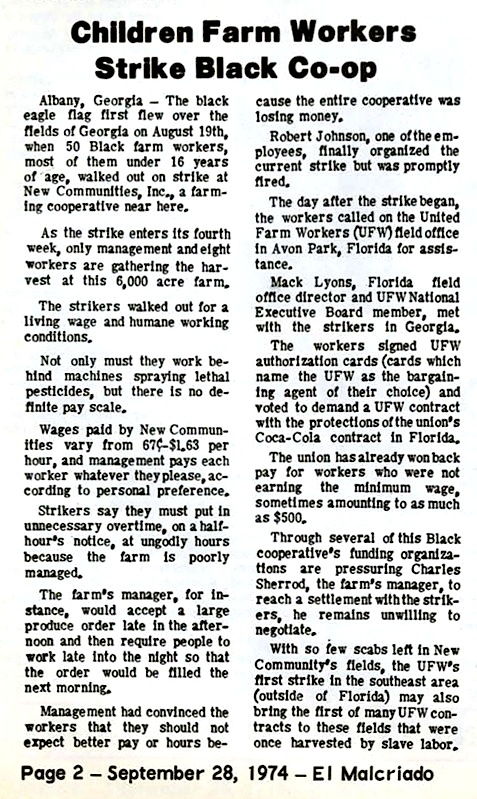I’m confused.
If there are only 39,697 African-American farmers grand total in the entire country, then how can over 86,000 of them claim discrimination at the hands of the USDA? Where did the other 46,303 come
from?
Now, if you’re confused over what the heck I’m even talking about, let’s go back to the beginning of the story:
Pigford v. Glickman
In 1997, 400 African-American farmers sued the United States Department of Agriculture, alleging that they had been unfairly denied USDA loans due to racial discrimination during the period 1983 to 1997.
The farmers won the case, known as Pigford v. Glickman,
and in 1999 the government agreed to pay $50,000 each to any farmer who
had been wrongly denied an agricultural loan. By then it had grown into
a class action case, and any black farmer who had filed a
complaint between 1983 and 1997 would be given at least $50,000 — not
limited to the original 400 plaintiffs. It was estimated at that time
that there might be as many as 2,000 beneficiaries granted $50,000 each.
According to the summary of the case linked above,
Originally, claimants were to have filed within 180 days of the consent decree. Late claims were accepted for an additional year afterwards, if they
could show extraordinary circumstances that prevented them from filing
on time.Far beyond the anticipated 2,000 affected farmers, 22,505 “Track A” applications were heard and decided upon, of which 13,348 (59%) were approved. US$995 million had been disbursed or credited to the “Track A” applicants as of January 2009, including US$760 million disbursed as
US$50,000 cash awards…. Beyond those applications that were heard and
decided upon, about 70,000 petitions were filed late and were not allowed to proceed.
Some have argued that the notice program was defective, and others
blamed the farmers’ attorneys for “the inadequate notice and overall
mismanagement of the settlement agreement”. A provision in the 2008 farm
bill essentially allowed a re-hearing in civil court for any claimant
whose claim had been denied without a decision that had been based on
its merits.
Then on February 23 of this year, the USDA finally consented to pay $1.25 billion to those farmers whose claims had ea...:
In the 1999 case Pigford v. Glickman, the USDA agreed to pay 16,000 black farmers $1 billion after a judge held the federal government responsible
for the decline in black farmers. Critics argued that more than 70,000
farmers were shut out of the lawsuit. In 2008, then-Sen. Barack Obama
and Republican Sen. Chuck Grassley got a law passed to reopen the case,
and the settlement talks moved forward.The $1.25 billion settlement, announced Thursday, comes on top of the money paid out a decade ago. The new agreement would provide cash payments and debt relief to farmers who applied too late to participate
in the earlier settlement, The Washington Post reported. Authorities say
they are not certain how many farmers might apply this time, but
analysts say the number could be higher than 70,000.
Seventy-thousand+ applicants in addition to the 16,000 already compensated now means that over 86,000 people are slated to be paid.
The U.S. Senate and Shirley Sherrod
Which brings us up to today, when two current events suddenly thrust this otherwise little-known case into the spotlight. First, the Senate stripped funding for the settlement out of an unrelated ..., as they had done several times in the past. Second, it was revealed today that “A farm collective founded by Shirley Sherrod and her husband that was forced out of business by the discriminatory practices received a $13 million settlement as part of Pigford last year, just before she was hired by the USDA.”
Suddenly, everyone in America is talking about a class-action suit that until a few hours ago very few had ever heard of.
But I want to go back to the beginning.
Forget about Shirley Sherrod’s connection. Forget about the Senate not funding the settlement. There will be plenty of pundits commenting on those aspects over the upcoming days.
What I want to know is: How can there be 86,000 legitimate claimants?
The Census pinpoints the precise number of African-American farmers
I ask this question because it didn’t take me very long to find the latest census statistics released by the Department of Agriculture, which can be found linked to from this official USDA page. There, you will find this direct link to a text version of the Census report, and this recommended pdf version.
In the pdf version of the government’s official 2007 Agricultural Census, Table 53 on page 646 shows that there are exactly 39,697 African-American farmers grand total in the entire nation:

(A scan through earlier census reports shows that this number has remained fairly constant over time, which is to be expected, as farming tends to be a long-term lifestyle rather than a “job” that one gets and
then quickly abandons.)
Granted: the original case was valid. But has it spun out of control?
Let’s accept as a point of fact that some African-American farmers were unfairly denied loans by racists in the USDA during the Clinton and Reagan administrations. I’m not casting any aspersions on the validity
of the original lawsuit, nor on the courts’ rulings in the case.
But ponder the numbers.
• There are approximately 40,000 African-American farmers in the country.
• Of that 40,000, not all of them have gotten into financial trouble. Some have successful farms.
• Of those who had financial trouble, not all of them sought out loans. Some tried to stay afloat on their own.
• Of those who sought out loans, not all of them sought out loans from the USDA. Some got loans from banks or friends.
• Of those who sought out loans from the USDA, not all of them were denied loans. Some got the loans as requested.
• Of those who were denied loans, not all of them were denied due to discriminatory racial practices.
In the end, a total much much smaller than 40,000 could legitimately claim to be victims of discrimination.
As shown above, it was originally estimated to be no more than 2,000 possible total plaintiffs.
Somehow, that number quickly swelled to 16,000 wronged claimants.
And now, as of February, the government has announced its plans to hand out at least $50,000 each to over 70,000 more claimants, over and above the original 16,000.
This means that the U.S. may be recompensing at least 86,000 African-American farmers for past racial discrimination. But how could that possibly be true if there are only 39,697 African-American farmers
in existence nationwide? And if only some subset of them ever applied
for loans in the first place and were then unfairly denied loans?
If someone can explain this to me, I’ll add it in an update to this post. Could it be that there is a constant turnover of African-Americans trying out farming for a few years, and then quickly giving it up, so
that although there may be only 40,000 farmers at any one time,
over the years, the total number of different people involved in
farming is much larger? If so, is there any evidence for this? Or could
there be another explanation?
I have a feeling that the Senate repeatedly fails to fund this settlement because there is a strong suspicion among the senators that something is amiss with the case — that a substantial percentage of the
70,000 claims that were originally rejected must necessarily have been
fraudulent claims. And so there is reluctance to fork over the money.
But there also seems to be a reluctance on the part of the Senate to
admit why they won’t fund the settlement, because the issue is just too racially charged.
It is a tragedy that victims of institutional discrimination like the legitimately wronged African-American farmers could be denied their payout due to scammers trying to undeservedly grab a piece of the pie.
Instead of getting angry at the Senate for hesitating with the funds, we
should be angry at the swindlers (and their lawyers) who contaminated
an otherwise valid case.
Unless, of course, there is a clear explanation of where those 86,000 farmers came from. Any ideas?
UPDATE I:
Another Department of Agriculture census report details the total number of African-American farmers in 1992, during the exact time covered by the Pigford v. Glickman lawsuit — and it reveals that there
were far fewer back then than there were in 2007. According to the chart on page 20 of the USDA’s pdf 1998 “Status Report, Minority & Women Farmers In..., there were only 18,816 black farmers in 1992:

(Thanks to reader “Dane” for noticing this.)
If this is true (and it seems to be), then the disparity between the available total number of black farmers in the U.S. and the number of claimants in Pigford v. Glickman is even far greater than I originally
calculated.
UPDATE II:
This official USDA census report, in Appendix 3 on page 24 of the pdf, gives even more statistics for 1987, 1992, and 1997 — every single agricultural census year during the
period covered by the lawsuit. Turns out that the number of black
farmers in every year was consistently very small:
Total number of African-American farmers in the United States, by year:
1987: 22,954
1992: 18,816
1997: 18,451
Even if there was a 100% turnover, and every single farmer went out of business every five years and was replaced by a new farmer (extremely unlikely), there still wouldn’t be enough black farmers throughout the entire period combined to account for the number of claimants.
It seems, no matter how you look at it, that a substantial number of the 86,000 claims must necessarily be fraudulent.

